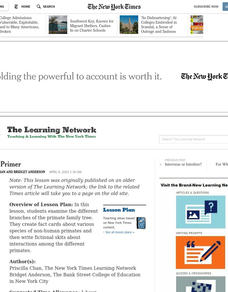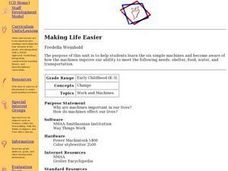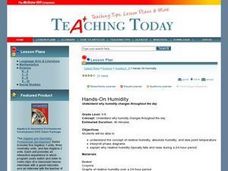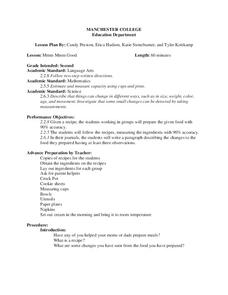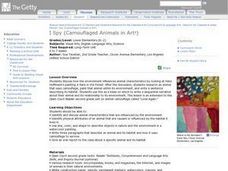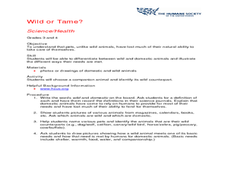Curated OER
Speedy Trials
Fifth graders investigate how forces affect the motion of an object. In this physics lesson, 5th graders calculate an object's speed using a mathematical formula. They discuss how force and mass affects the speed.
Curated OER
Primate Primer
Students examine the different branches of the primate family tree. They create fact cards about various species of non-human primates and then write fictional skits about interactions among the different primates.
Curated OER
Making Hail
Fourth graders investigate the different types of precipitation and conduct a hail experiment. They identify the types of precipitation during a slideshow, and define key vocabulary terms. Next, in small groups they follow the...
Curated OER
Change It
Fourth graders expand their knowledge about how the physical properties of a substances can be changed. They are given multiple opportunities, using first-hand experiences and familiar objects in different contexts, to identify...
Curated OER
The Sun in Our Lives
Third graders identify the different parts of the sun. In this astronomy lesson plan, 3rd graders examine how the sun's energy drive life processes on Earth. They construct a model of a solar system using large rolls of toilet paper.
Curated OER
Making Life Easier
Students use a chart of the six simple machines and become aware of how the machines improve our ability to meet the following needs: shelter, food, water, and transportation. Students use model cars to experiment with force. They divide...
Curated OER
Stranger Than Fiction
Students reflect on the importance of science literacy. They review the year's science curriculum by reading, discussing and writing questions on teacher-selected New York Times articles and the related science content.
Curated OER
Habitat Awareness
Second graders build a habitat. In this wildlife activity, 2nd graders work in groups to build a mammals habitat. They share their habitat with the class.
Curated OER
Hands-On Humidity
Students examine why humidity changes throughout the day. They study the concept of relative humidity, absolute humidity, and dew point temperature. They interpret phase diagrams and explain why relative humidity typically falls and...
Curated OER
It's Everyone's Home
Students research environmental destruction. In this cause and effect lesson, students students gain an understanding of everyday things we do to harm the environment. Students work in groups to create a brochure that tells the...
Curated OER
East Meets West: Americans on the Move
Students imagine what it was like to be part of the Lewis and Clark expedition. In this Lewis and Clark Expedition lesson, students watch "East Meets West: Americans on the Move," and then write journal entries from the...
Curated OER
A Chair for Mr. Bear
Young scholars listen to Goldilocks and the Three Bears, and work collaboratively to create a chair for a small stuffed animal that will allow it to sit upright and withstand a short drop out of Legos. Students write about the...
Curated OER
Mmm Mmm Good
Second graders follow a recipe. In this cooking instructional activity, 2nd graders are given a recipe and ingredients to prepare food. Students will reflect on their experience in their journals.
Curated OER
Celebrating Women: Toni Morrison
Students research Toni Morrison's life, work as a writer, and major contributions to the field of literature; students choose one of her novels to read, & perform a scene from it; each group member writes an autobiographical essay...
Curated OER
Changing of the Guard
Students reflect on their knowledge of democracy. After reading an article, they examine current plans for the placement of a democracy in Iraq. In groups, they research past regime changes and democratization attempts and discuss the...
Curated OER
An Introduction to Light Unit-Third Grade
Third graders are introduced to light in an eight part unit which includes activities, additional resources, and rubrics for each part. Students address topics such as energy, reflection, absorption, and refraction through hands-on...
Curated OER
I Spy (Camouflaged Animals in Art!)
Make connections about animal characteristics and the animal's environment. In this animal characteristics lesson plan, students use a piece of art as a springboard for a discussion about animals and camouflage. Students choose an animal...
Curated OER
The Queen's Empire
Students conduct Internet research on a variety of ant species and their habitats. They have an opportunity to observe ants in their environment. Areas of interest might include ant identification, colony life, the ant life cycle, and...
Curated OER
Peter the Great
Students recognize that Peter the Great modernized Russia. They write letters and complete journal entries in first person as if they were Peter the Great. In addition, they decorate their journal entries with scenes from his travels.
Curated OER
I spy (Camouflaged Animals in Art!)
Students create a picture of a camouflaged animal in its habitat. In this visual arts lesson, students look at Hans Hoffmann's painting A Hare in the Forest and discuss the animal's camouflage. They research their own animal to...
Curated OER
Energizing Resources
Seventh graders describe electrical energy and how it is produced. In this natural resource lesson, 7th graders explain the various ways of obtaining and using natural resources for energy and the environmental consequences. They will...
Curated OER
Compare Human-made Objects with Natural Objects
Students examine and observe how many human-made objects get their basic design from things in nature. They listen to the book "Nature Got There First," compare/contrast hollow bones with drinking straws, bird beaks and tool pliers, and...
Curated OER
Rules of Force and Motion
Students view a video and complete experiments with force and motion. In this force and motion lesson, students examine small pieces and how they affect the motion of a toy car. Students also experiment with sand paper,...
Curated OER
Wild or Tame?
Learners explore wild and domestic animals. In this animal activity, students define wild and domestic. Learners are shown pictures of animals and choose if they are wild or domestic. Students name pets and name their wild counterpart....

